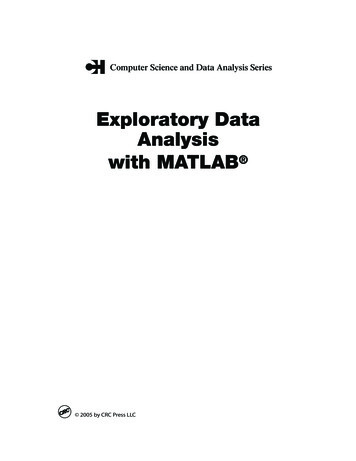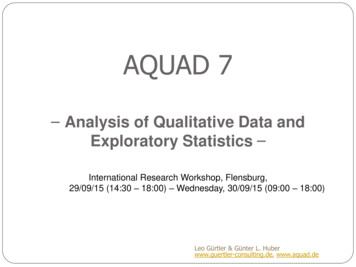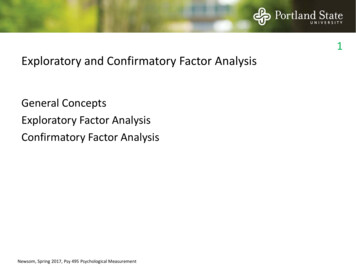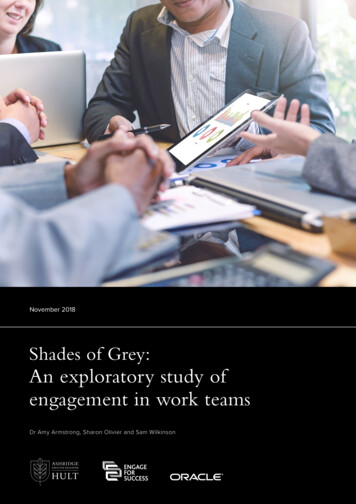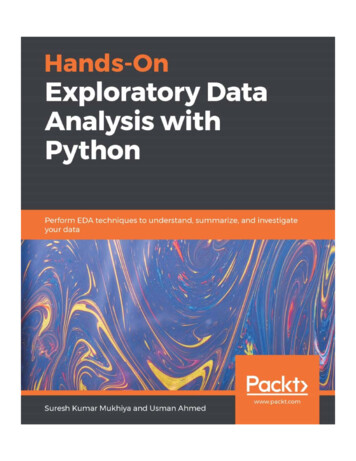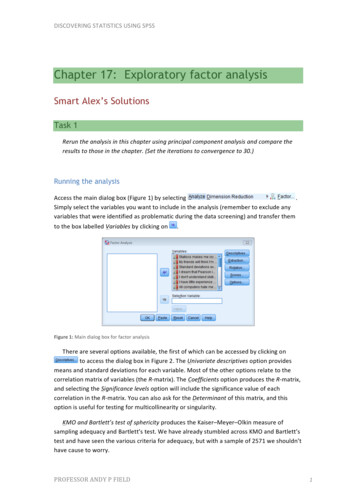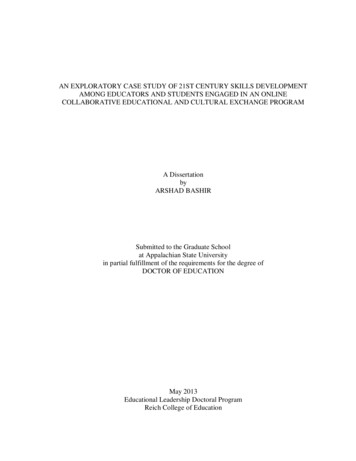
Transcription
AN EXPLORATORY CASE STUDY OF 21ST CENTURY SKILLS DEVELOPMENTAMONG EDUCATORS AND STUDENTS ENGAGED IN AN ONLINECOLLABORATIVE EDUCATIONAL AND CULTURAL EXCHANGE PROGRAMA DissertationbyARSHAD BASHIRSubmitted to the Graduate Schoolat Appalachian State Universityin partial fulfillment of the requirements for the degree ofDOCTOR OF EDUCATIONMay 2013Educational Leadership Doctoral ProgramReich College of Education
AN EXPLORATORY CASE STUDY OF 21ST CENTURY SKILLS DEVELOPMENTAMONG EDUCATORS AND STUDENTS ENGAGED IN AN ONLINECOLLABORATIVE EDUCATIONAL AND CULTURAL EXCHANGE PROGRAMA DissertationbyARSHAD BASHIRMay 2013APPROVED BY:Vachel W. Miller, Ed.D.Chairperson, Dissertation CommitteeRobert L. Sanders, Ed.D.Member, Dissertation CommitteeJohn H. Tashner, Ed.D.Member, Dissertation CommitteeJim Killacky, Ed.D.Director, Educational Leadership Doctoral ProgramEdelma D. Huntley, Ph.D.Dean, Cratis Williams Graduate School
Copyright by Arshad Bashir 2013All Rights Reserved
AbstractAN EXPLORATORY CASE STUDY OF 21ST CENTURY SKILLS DEVELOPMENTAMONG EDUCATORS AND STUDENTS ENGAGED IN AN ONLINECOLLABORATIVE EDUCATIONAL AND CULTURAL EXCHANGE PROGRAMArshad Bashir, B.Sc., Punjab University, PakistanB.Ed., Federal College of Education, PakistanM.Sc., University of Arid Agriculture, PakistanEd.D., Appalachian State University, USAChairperson: Vachel W. MillerThe purpose of this qualitative study was to explore 21st century skills amongeducators and students engaged in an online collaborative educational and cultural exchangeprogram between middle and high school students and teachers in Heavy Industries TaxilaEducation City (HITEC), Pakistan and Watauga county schools in western North Carolina.The program was initiated by the Appalachian State University Public School Partnershipand featured online collaboration between students and teachers in Pakistan and the UnitedStates. Science, social studies, and language arts were identified as core subjects. Educatorsidentified common curriculum contents to develop semester long projects in which studentswere engaged in online collaborative learning experiences through cultural activities such asdigital photo sharing and storytelling to improve their cultural competency and globalawareness.A survey of all participants engaged in the program was conducted to determine thebaseline knowledge of the participants. Additionally, interviews of ten students, fouriv
teachers, and two administrators were conducted to understand how such programs foster21st century skills among students and teachers. Observation of participants during theirengagement in collaborative activities and focus group conversations was organized toexplore the learning experience of participants engaged in the program.The research study found that the engagement of students and teachers in the USPakistan Educational and Cultural Exchange Program resulted in the development of key21st century skills among participants of the program. These skills include global awareness,cross-cultural competency, creativity, collaboration, communication, and social networking.The research findings are helpful for school administrators to make progress in internationalcollaboration and implementation of 21st century skills. The outcomes of this researchprovide an opportunity to improve relationships between the two countries and to open newavenues for future joint ventures in addition to improving perceptions about each other.v
AcknowledgmentsI would like to offer my sincere appreciation to all those who contributed in thecompletion of my doctoral journey. Many thanks to my committee chair, Dr. Vachel Miller,for his consistent support and guidance throughout my doctoral program. He is the one whorefined my thoughts into concrete ideas. His professional knowledge of internationaleducation and cultural exchange has been a catalyst for identifying and developing myresearch project. Without his genuine guidance and persistent supervision this dissertationwould not have been completed. My committee members, Dr. Robert Sanders and Dr. JohnTashner, played a pivotal role in developing the conceptual framework of my study. I amgrateful for their invaluable input and professional expertise. Their intellectual and scholarlyguidance kept me on track to finish my research work in a timely manner.I am indeed grateful to Dr. Jim Killacky for his immense support and assistancethroughout my doctoral journey. His recommendations helped me to present my doctoralresearch project at three international and several regional conferences in the last four years.My acknowledgments would remain incomplete without mentioning my cohort members. Iwould not have reached this far without their professional and personal assistance at each andevery stage of my doctoral journey.I also offer my sincere appreciation to Dr. Linda McCalister at the Public SchoolPartnership for helping me to design my research project at partner schools in NorthCarolina. Additionally, Heavy Industries Taxila Education City (HITEC), a partner school inPakistan, facilitated my research. This research project would never have been accomplishedvi
without the active engagement of the students, teachers, and principals at Watauga HighSchool, Hardin Park School, Green Valley School, HITEC Cambridge School, HITEC GirlsSchool, and HITEC Boys School. I would like to extend my deepest appreciation to allparticipants for their valuable time, commitment, and engagement in my research project.Additionally, I am grateful to the Fulbright Program and the United StatesEducational Foundation in Pakistan for their administrative and financial support of mydoctoral studies at Appalachian State University. I am also indebted to the people of theUnited States for their valuable contribution, which makes the Fulbright programs possiblefor the people of other nations.Most importantly, I appreciate the lifelong efforts of my family including mydedicated father, inspirational mother, zealous brother, and passionate sisters. I can’t forgetthe invaluable and inspirational contribution of my wife who stays with me to provide astrong support for my doctoral journey. They all provided me with a strong foundation togrow in my life and achieve my professional and personal goals. I am so blessed to havethem as integral parts of my life.vii
DedicationThis work is dedicated to young children in Pakistan and the United States whoparticipated in the US-Pakistan Educational and Cultural Exchange Program with a hope thatthey will work for sustainable peace between Pakistan and the United States.viii
Table of ContentsAbstract . ivAcknowledgments . viDedication . viiiList of Tables . xvList of Figures . xviChapter 1: Introduction . 1Overview of the Study . 2Background of the Study . 3US-Pakistan Educational and Cultural Exchange Program . 5Brief description of the emergence of the exchange program . 6Doctoral internship at HITEC . 8Activities of participants in the program. 921st Century Skills Context . 9Globalization Context . 12Partner Schools . 13Partner schools in Pakistan (HITEC) . 13Partner schools in western North Carolina, US . 14Watauga High School. 14Hardin Park School . 15Green Valley School . 15ix
Research Statement . 16Research Questions . 16Brief Description of Data Collection. 17Significance and Implications . 17Definition of Key Terms. 20Chapter 2: Literature Review . 23Skills Needed for the 21st Century . 23Learning skills . 25Collaborative groups and the acquisition of learning skills . 25Project-based teaching . 27Creativity through digital story-making . 28Technology skills . 28Dependence on technology for learning skills . 29Integration of technology in the classroom . 30Life and career skills . 31Global awareness . 31Cultural competency . 32Models of 21st Century Skills. 32The partnership for 21st century skills model . 3321st Century Skills and Online Exchange Programs . 35Theoretical Context of the Study . 36Globalization: A theoretical context of the study . 36Learning theories: A theoretical context of the study . 39x
Chapter 3: Research Methodology . 41Context of the Study . 41Research Questions . 42Research Methodology . 42Rationale for a qualitative case study . 43Rationale for the case study method . 44Data Collection . 45Data collection sites . 45Data collection description . 46Participant selection method . 46Data collection methods . 47Baseline knowledge questionnaire . 47Interviews of students, teachers, and administrators . 47Focus group conversations . 50Participant observation . 50Document review . 51Online data (NING). 51Data Analysis . 53Codes and subcodes . 53Trustworthiness . 55Researcher’s Subjectivity . 55Strength of the Study . 56Chapter 4: Research Findings . 58xi
Observation in Pakistan . 59Observation in the US . 61Qualitative Data Presentation . 63Attainment of Global Awareness and Cultural Competency (Students) . 64Improvement of knowledge about partner country . 64Breaking of stereotypes . 67Understanding of other cultures . 69Attainment of Global Awareness and Cultural Competency (Teachers) . 70Knowledge about the partner country. 70Breaking of stereotypes . 71Understanding of other cultures . 73Development of Creative and Collaborative Skills (Students) . 73Sharing work in teams . 74Alternate ways of teaching and learning . 76Development of Creative and Collaborative Skills (Teachers) . 76Sharing work in teams . 77Alternate ways of teaching and learning . 78Student Growth in Technology Skills . 78NING as social medium of communication . 79Integration of technology in classroom activities . 80Project encouraged “switching on the computers” . 83Administrator’s Vision of Implementing 21st Century Skills . 84Conceptual understanding of 21st century skills by school administrators . 84xii
Educational exchange program as tool for implementing 21st century skills. 87Commitment for support system for implementing 21st century skills. 89Summary of the Chapter . 91Chapter 5: Analysis and Implications . 92Introduction and Overview of the Study . 92Analysis . 93Attainment of global awareness and cross-cultural competency . 93Development of creative and collaborative skills. 99Student growth in technology skills . 101Summary of the Analysis . 104Revisiting the Conceptual Framework . 105Are 21st century skills truly global? . 106Bridging the Knowledge Gap . 107Limitations of the Study . 107Implications of the Study . 108Recommendations for Further Research . 110Conclusions . 111References . 116Appendix A: Lay Summary . 127Appendix B: Baseline Knowledge Survey Questionnaire . 129Appendix C: Baseline Knowledge Survey Questionnaire (Pakistani participants) . 130Appendix D: Baseline Knowledge Survey Questionnaire (American participants) . 131Appendix E: Pre-Project Interview Questions for Students . 132xiii
Appendix F: Post-Project Interview Questions for Students . 133Appendix G: Focused Group Conversation Questions for Students . 135Appendix H: Interview Questions for Teachers . 136Appendix I: Interview Questions for Administrators (Principal and Director) . 137Appendix J: Informed Consent Form . 138Appendix K: Information Release and Waiver Form . 141Appendix L: Partnership Agreement . 142Appendix M: Framework for 21st Century Learning . 146Appendix N: 21st Century Skills in North Carolina . 148Vita . 150xiv
List of TablesTable 1: Overview of Interviews with Participants . 49Table 2: Description of Data Collection . 52Table 3: Summary of Codes and Subcodes . 54Table 4: Summary of Themes and Subthemes . 63xv
List of FiguresFigure 1: Model of 21st Century Skills . 34Figure 2: Kohls Model of Iceberg Culture . 98xvi
1Chapter 1: IntroductionHow should we teach our children to live together and appreciate other cultures inthis globalized world, and in what ways should we prepare them to become global citizens?In order to achieve the important goal of becoming a global citizen, it is important to developcross-cultural competency, creativity, collaboration, and communication that support theeducational and social lives of individuals. Technology plays a pivotal role in becoming aglobal citizen as it provides an interactive medium to collaborate, communicate, and learnfrom each other.This study is an effort to investigate the development of 21st century skills through aneducational and cultural exchange program at the middle and high school levels. This studywill focus on an online collaborative educational and cultural exchange program betweenmiddle and high schools in the Heavy Industries Taxila Education City (HITEC), Taxila,Pakistan and schools in western North Carolina (NC), US with the major objective ofproviding an online forum to students and teachers in two different countries in order todevelop 21st century skills.In the introductory chapter, the conceptual framework of 21st century skills in thecontext of an educational and cultural exchange program is illustrated. In addition, thebackground of the study, along with a comprehensive account of 21st century skills andeducational exchange programs, is presented. The chapter also includes a description of theUnited States (US)-Pakistan Educational and Cultural Exchange Program. The research
2statement and research questions are documented along with the significance andimplications of the study.Overview of the StudyThe study was intended to contribute toward better understanding of 21st centuryskills by conducting qualitative research on students engaged in an online internationalexchange program. The study provided a comparative account of participants’ worldviewsand perceptions about 21st century skills while engaged in such programs in geographicallyand culturally different places. How do students engaged in such programs in the USenvision the skills that they develop similarly or differently from students who are engaged insimilar programs in Pakistan?A long list of skills is mentioned in all 21st century skills models. Keeping in viewthe age group of the participants, selected skills were considered for this study. These skillsare appropriate and relevant to the participants of this study. Out of many 21st centuryskills, I considered three major skills as the focus of this study: (a) life and career skills,which include global awareness and cultural competency; (b) learning skills, which includecreativity and collaboration, and (c) technology skills, which include communication andintegration.Participants were selected from collaborative groups engaged in the US-PakistanEducational and Cultural Exchange Program between schools in HITEC, Taxila, Pakistanand in western NC, US. In Pakistan, there were three participating schools: HITECCambridge School, HITEC Girls School, and HITEC Boys School. Similarly, in the US,there were three participating schools: Watauga High School, Hardin Park School, and GreenValley School.
3Background of the StudyIn the summer of 2007, I came to Appalachian State University (ASU) to participatein the Fulbright Biology Teacher Exchange Program. The exchange program involved 15Pakistani biology teachers and ASU faculty from diverse fields and made use of theuniversity's partnership with the NC school districts. The training program contributed to thegoal of developing science and educational technology skills while strengthening therelationship between Pakistani and American educators. The program was a greatopportunity for capacity building of educators in Pakistan and the US and resulted in thedevelopment of positive attitudes for the use of innovative methodologies, integration oftechnology in the classroom, and improvement of English language usage. In addition tothese professional accomplishments, the program helped the educators to broaden theirworldviews and improve their cross-cultural competency.This trip was my first visit to the US and my first opportunity to engage in anyeducational or cultural exchange programs. This program helped me to improve myprofessional and pedagogical skills. As a result of my engagement in the exchange program, Ideveloped several new skills, which included improved global awareness, communication,collaboration, innovation, creativity, integration, and cross-cultural competency.On my return to Pakistan, I practiced these newly learned skills and successfullyapplied the learning experience at my workplace. I realized that the skills I had developed inthe program are essential for success in the 21st century. I was amazed by the application oftechnology in education that I had never before experienced. I used technology such as email,social networking, electronic documents, and spreadsheets for my personal connections andprofessional work. After the exchange program, I engaged my students and staff in using
4computer and communicative technology to improve the efficiency and quality of their work.The students and staff found the experience interesting, innovative, and useful in theirlearning process.After experiencing and understanding a different learning environment in the US, Inoticed that my ability to envision issues and problems greatly improved. I startedappreciating the value of multicultural diversity and multi-perspective thinking. The programprovided me with an opportunity to learn from working collaboratively with individualsrepresenting diverse cultures and improved my cultural competency. I realized that culturalcompetency is necessary in order to become competitive in today’s world. This attitudinalchange broadened my way of thinking and enabled me to see the world with a different frameof mind. My worldview had greatly changed to allow me to better understand theinterconnectedness of everything in this world.In 2009, I received another Fulbright Scholarship to return to the US in order toparticipate in the doctoral program in Educational Leadership at ASU. The doctoral programat ASU is based on the principles of diversity, effective communication, cooperation, andcollaboration. The theoretical foundation of the program is supported by practical learningexperiences. The doctoral program provided a strong theoretical basis; project-based coursesfocused on globalization and leadership while the organizational systems available at ASUhelped to establish a practical framework for action. The unique structure of the cohort modelprovided me with another opportunity to understand and practice the important skillsessential for success in the 21st century.I believe success in the 21st century depends on better collaboration, effectivecommunication, and broader understanding of this globalized world. Therefore, it is
5important to develop these skills among students and teachers in order to prepare them forfuture challenges. Darling-Hammond (2007) recommended that students in the 21st centurymust use both content and digital tools to design, evaluate, and analyze information to solvereal life problems.US-Pakistan Educational and Cultural Exchange Program. The idea of aneducational and cultural exchange program between Pakistan and the US was a uniqueadventure because of the fragile and sensitive relationship between the two countries. Peopleliving in the two countries are unable to develop deeper relationships due to cultural andgeographical barriers. Historically, the relationship between the two countries has been seenas transactional deals to serve the vested interest of each other; a sincere cultural friendshiphas been missing from the relationship. In both Pakistan and the US, many people aredisconnected from government policies. Since the government policies in both countries donot truly represent the perceptions of the people, most of the people in Pakistan and the USdo not show warmth in their relationships and may carry misconceptions and stereotypesabout each other. Under such circumstances, initiating an educational and cultural exchangeis essential but also very challenging.Most of the participants of the exchange program in Pakistan and the US were bornafter the September 11 incident, and they were raised in a different political and educationalenvironment. After the September 11 incident, Pakistan became a front ally of the US in thewar against terrorism. The relationship between the two countries was heavily influenced bymilitary and intelligence cooperation due to an ongoing war in the neighborhood of Pakistan.The exchange program establishes a context where participants in both countries may thinkbeyond a military relationship and progress toward an educational and cultural relationship.
6This exchange program provides an opportunity for young people in both countries tocontextualize their opinions based on personal, academic, and cultural relationships.Most of the models of educational exchange are found at higher educati
21st century skills among participants of the program. These skills include global awareness, cross-cultural competency, creativity, collaboration, communication, and social networking. The research findings are helpful for school administrators to make progress in international collaboration and implementation of 21st century skills.

